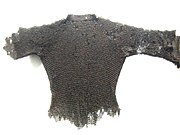
The extended use of mail over time is due, in part, to its technological simplicity and its ease of production, as the steps in the process are fairly straightforward, though it is still a labor intensive job. The first step involves the smelting of iron, and after that, one must make the wire. Making the wire requires the use of small, thin sheets of iron and then shearing thin strips off the sides of this sheet in order to form square wires, or using another method, one can repeadetly beat and shape small iron pieces into narrow rods in order to form the raw material needed for wire.
After making the rods, the armorer must reheat and draw the strips through conical holes in a metal block to form round wire, and if thinner wire is needed, he can repeat this step several times using narrower holes. Once the wire is reduced to the desired diameter, it is then wrapped around a metal rod to create long, spring-like coils. The armorer then cuts along the length of the coil, down one side with shears or hammer or cutting chisel, and this causes the coils to separate into individual rings. Each ring is then flattened with a tool called a die, or something similar, and while flattening, the die also punches holes in each end of the ring. The armorer then overlaps the ends of each ring and rivets them shut. This process of flattening, punching with a die, joining the rings together, and then riveting them might have to be repeated thousands of times in order to make a single shirt of mail.
A mail shirt was also known as a hauberk. A hauberk, according to Terrence Wise in Medieval Warfare, is a mail shirt covering the body as far as the knees, the arms ending in mittens, and with a hood for the head (249). A haubergeon, or habergeon, is “a shortened version of the hauberk, worn by both infantry and mounted men, those for the former usually having short sleeves” (Wise, 248). Only the wealthy — the nobles — could afford to purchase mail shirts, and so a hauberk became a symbol of rank for the warrior class of society.
The iron links of the mail shirt provided a strong layer of protection and flexibility for the wearer. The overlapping rings allowed a slashing or cutting blow from a sword to glance off without penetrating into the skin; though a smashing blow from a club could still shatter or break or crush bones. For this reason — to prevent the breakage of bones — a knight would wear a layer of padded armor, or an aketon, underneath the mail. So the combined layers of padded tunic and mail gave the knight a suit of armor that was nearly impervious to cutting and slashing and also protective against the heavy, smashing blows often delivered on the medieval battlefield.
Sources:
Newman, Paul B. Daily Life in the Middle Ages. Jefferson, NC: McFarland & Company, Inc., 2001.
Baker, Alan. The Knight. Hoboken, New Jersey. John Wiley & Sons, Inc., 2003.
Wise, Terrence. Medieval Warfare. Osprey Publishing, 1976.
*image retrieved from Wikipedia (http://en.wikipedia.org/wiki/Chain_mail)
Very interesting post!
Thanks, Tanzanite. Glad you enjoyed it.
very helpful post!